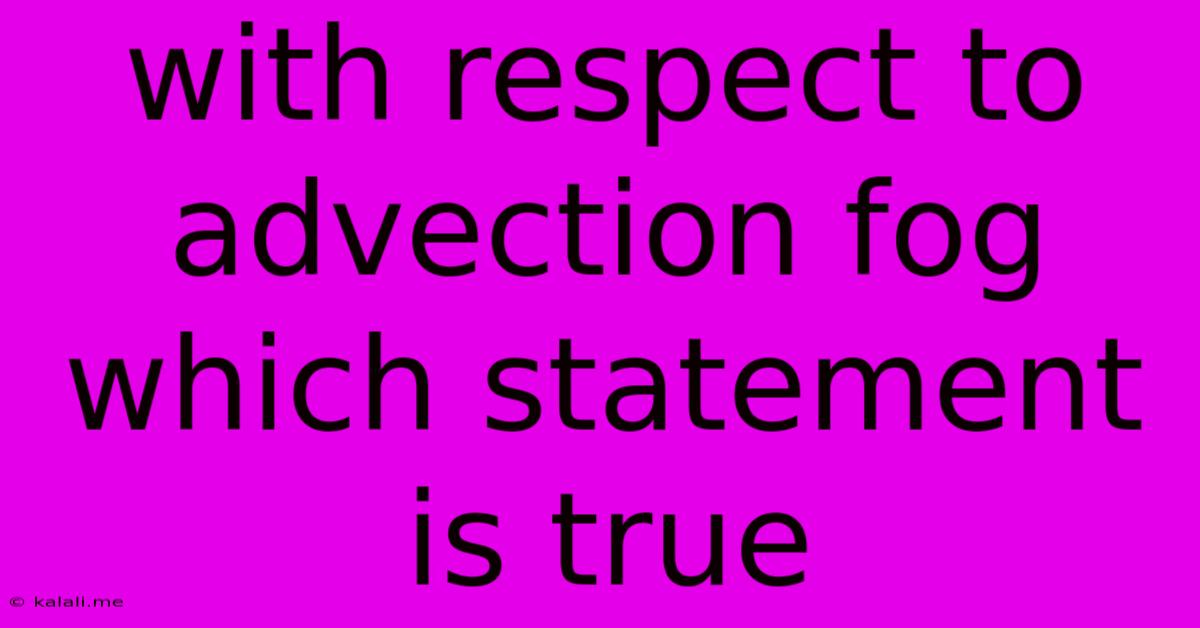With Respect To Advection Fog Which Statement Is True
Kalali
Jun 13, 2025 · 3 min read

Table of Contents
With Respect to Advection Fog, Which Statement is True? Understanding Fog Formation and Types
Advection fog is a common meteorological phenomenon, often causing reduced visibility and impacting transportation. Understanding its formation is crucial for predicting weather patterns and ensuring safety. This article explores the characteristics of advection fog and clarifies which statements regarding its formation are true. We'll delve into the science behind it, differentiating it from other fog types, and providing clear, concise explanations.
What is Advection Fog?
Advection fog forms when warm, moist air moves over a colder surface. This process cools the air to its dew point, causing water vapor to condense into tiny water droplets suspended in the air – fog. Unlike other fog types, advection fog's development is primarily driven by the horizontal movement of air masses, not necessarily by cooling from below (radiation fog) or the mixing of air masses (evaporation fog). Therefore, a key characteristic is the presence of a significant temperature difference between the warm, moist air mass and the cooler surface.
Understanding the Statements Regarding Advection Fog
Several statements could be made about advection fog. Let's analyze which one holds true:
True Statement: Advection fog forms when warm, moist air moves horizontally over a significantly colder surface.
This statement accurately captures the essence of advection fog formation. The horizontal movement ("advection") of the warm, moist air is the primary driver, and the substantial temperature difference between the air and the surface is essential for the condensation process to occur.
False Statements (and why they are false):
- Advection fog forms primarily through radiative cooling of the ground: This describes radiation fog, where the ground cools overnight, cooling the air above it to its dew point.
- Advection fog requires significant upward air movement: While some vertical mixing might occur, the defining characteristic of advection fog is horizontal movement.
- Advection fog only forms over land: While common over land, advection fog can also form over water when warmer, moister air flows over a colder water body.
- Advection fog always dissipates quickly: The persistence of advection fog depends on the duration and strength of the warm, moist air flow and the temperature difference with the underlying surface. It can persist for extended periods.
Key Factors Affecting Advection Fog Formation:
- Temperature difference: A larger temperature difference between the air mass and the surface leads to more efficient cooling and greater fog formation.
- Moisture content: The higher the moisture content of the warm air mass, the more readily water vapor will condense into fog.
- Wind speed: A moderate wind speed is ideal. Too little wind prevents efficient advection, and too much wind can mix the air, preventing sufficient cooling for fog formation.
- Stability of the air mass: A relatively stable air mass is more conducive to fog formation as it prevents turbulent mixing that could dissipate the fog.
Differentiating Advection Fog from Other Fog Types:
Understanding the formation mechanisms helps differentiate advection fog from other types:
- Radiation fog: Forms through ground cooling during clear nights.
- Evaporation fog (steam fog): Forms when cold air moves over warmer water, evaporating water into the cold air, causing it to saturate and form fog.
- Upslope fog: Forms when moist air is forced to rise along a slope, cooling adiabatically.
Conclusion:
Advection fog, characterized by the horizontal movement of warm, moist air over a colder surface, is a significant meteorological phenomenon. Understanding its formation process is crucial for accurate weather forecasting and safety precautions. By recognizing the key factors involved, we can better predict the occurrence and persistence of this important fog type. Remembering that warm, moist air moving horizontally over a cold surface is the core principle clarifies the true statement about advection fog formation.
Latest Posts
Latest Posts
-
How To Write 800 In Words
Jun 14, 2025
-
What Is The Last Step In The Communication Process
Jun 14, 2025
-
What Is The Resistance Of An Ideal Voltmeter
Jun 14, 2025
-
Which Of The Following Is A Decomposer
Jun 14, 2025
-
Which Of The Following Is An Example Of A Saprotroph
Jun 14, 2025
Related Post
Thank you for visiting our website which covers about With Respect To Advection Fog Which Statement Is True . We hope the information provided has been useful to you. Feel free to contact us if you have any questions or need further assistance. See you next time and don't miss to bookmark.